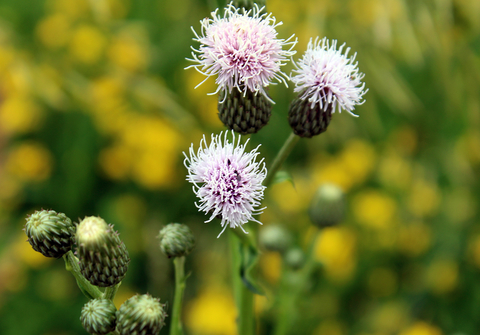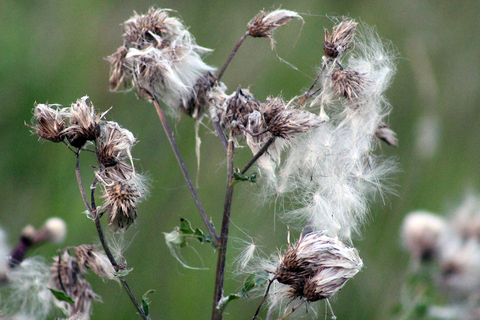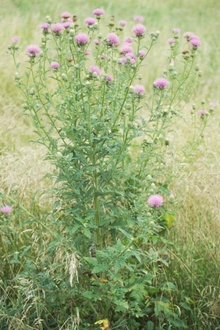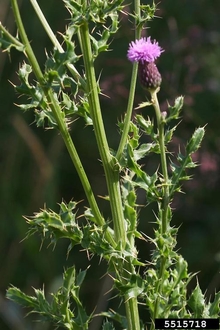Quick facts
Canada thistle is an invasive species and is on the noxious weed list meaning you must prevent the spread of this plant.
- The Canada thistle can be distinguished from other thistles by its small purple flower, horizontally growing roots, and lack of stem spines.
- It aggressively spreads by roots and seeds. Small root pieces only several millimeters long can produce new plants.
- Canada thistle is found in natural areas such as prairies, savannas, glades and dunes.
- It prefers wet areas such as streambanks, sedge meadows and wet prairies.
- Introduced thistles can destroy habitat and outcompete desired plants, but native thistles are beneficial to fauna and do not often become weedy.
Canada thistle should be reported. The Minnesota Department of Natural Resources provides detailed recommendations for reporting invasive species.
Characteristics
Canada thistle (Cirsium arvense) is one of the most common thistles found in yards and gardens in Minnesota. This invasive perennial thistle is on the Minnesota Department of Agriculture (MDA) Prohibited-Control Noxious Weeds list due to its aggressive spread by seed and roots, which allows it to outcompete other plants.
Canada thistle grows between 3 and 5 feet tall and has numerous small purple flowerheads per plant.
Flowers, fruit and seeds
- Bloom time: June - September.
- Blooms between 0.5-1inches; from numerous branching stems.
- Bracts underneath flowers do not typically have spiked tips.
- Male and female flowers grow on separate plants, although imperfectly dioecious (male and female on different plants) plants have been found.
- Female flowers are fragrant; male flowers are not.
- Light brown seeds spread by wind and animals on female plants.
- Feathery plumes are formed on each seed.
- Canada thistles can produce up to 10,000 seeds per plant.
Leaves
- Alternate growth.
- Leaves have wavy edges and spines along the margin.
- Leaf margins can range from smooth to deeply lobed.
- The upper leaf surface is generally smooth and its underside can be smooth to slightly hairy.
- Canada thistle starts growth as a basal rosette before forming an upright stem.
- Basal rosettes do not always precede upright stems.
Stem and roots
- Stems are grooved and hairless to slightly hairy.
- Stems become hairier with age.
- Stems generally do not have spines.
- Can be used to tell Canada thistle apart from bull thistle and plumeless thistle.
- Upper parts of the stem have a branching structure.
- Roots form a deep fibrous taproot with far-reaching horizontal adventitious roots that can create new plants.
- Horizontal roots can spread up to 10 feet in a growing season.
- Most other thistle species do not have aggressive horizontal adventitious roots, so their presence can be used to assist in identification.
- Canada thistle stems have clear sap.
- Sowthistles often have milky sap and yellow flowers.
Where it thrives
Canada thistle thrives in disturbed soils of both managed and natural landscapes. This thistle prefers full, direct sun and moist soils, but its deep taproot and wide horizontal roots allow it to adapt to many different moisture and light conditions.
Canada thistle is suspected to have allelopathic qualities and depletes nutrients and moisture from the soil, making it a competitor of desirable plants.
Control and management
Canada thistle requires committed removal to control its spread. Small root pieces only several millimeters large can grow new plants, and seeds may survive for up to 20 years in soils.
If possible, Canada thistle should be controlled on-site following the MDA’s Guide to Noxious Weed Disposal to minimize spread.
While there are many noxious and aggressive introduced thistles in Minnesota, there are also many native thistles. Native thistles provide habitat and food sources for different birds and insects. Although animals that consume native thistles control their spread, introduced thistles have fewer natural enemies. The lack of natural enemies can cause an uncontrolled spread of introduced thistles that doesn’t occur often in native thistles.
Common introduced thistles include:
Common native thistles include:
- Field thistle
- Tall thistle
- Flodman’s thistle
Turf
- Hand removal is effective for removing individual plants or small patches.
- Remove as much of the stem and roots as possible to prevent regrowth.
- Remove before plants go to seed.
- Mowing can prevent Canada thistle from flowering and going to seed but will not prevent spread by root.
- Do not mow Canada thistles once they have gone to seed.
- Mowing can take several years to be effective.
- Combinations of fall and spring herbicide applications are most effective.
- Post-emergent herbicides:
- 2-4D, Dicamba, MCPA, fluroxypyr, triclopyr, clopyralid, picloram, metsulfuron
- Herbicides should move nutrients into the plant’s root system for the most effect.
- Post-emergent herbicides:
Garden
- Hand removal is effective for removing individual plants or small patches.
- Remove as much of the stem and roots as possible to prevent regrowth.
- Remove before plants go to seed.
- Some success has been shown in Canada thistle removal by shading out the plant.
- Combinations of fall and spring herbicide applications are most effective.
- Herbicides should be spot-sprayed to prevent unintended damage.
- Post-emergent herbicides:
- 2-4D, triclopyr, glyphosate
Benefits to the landscape
Canada thistle should not be planted or propagated in Minnesota.
Parts of existing plants are recognized as edible. Many cultures have also used this thistle for medicinal purposes.
Canada thistle is an introduced weed, but native thistles provide habitat and a source of food for many different species of insects and birds.
Conservation, invasive status, and native status
- Prohibited-Control Noxious Weed.
- Introduced.
- Canada thistle is native to southeast Europe and Asia and was likely introduced to North America in the 1600s via agricultural seed.
- This plant is called Canada thistle because its introduction into New England was blamed on French-Canadian fur traders.
Plants that look similar
- Bull Thistle
- Plumeless Thistle
- Spotted Knapweed
- Assorted thistle species
CAUTION: Mention of a pesticide or use of a pesticide label is for educational purposes only. Always follow the pesticide label directions attached to the pesticide container you are using. Be sure that the area you wish to treat is listed on the label of the pesticide you intend to use. Remember, the label is the law.
Cameron, S., & Wheeler, J. (n.d.). Invasive Plant Profile: Canada and Bull Thistles. National Park Service. https://www.nps.gov/articles/000/canada-and-bull-thistles-acadia.htm#:~:text=Canada%20thistle%20was%20also%20found,damaging%20to%20pastures%20and%20crops
Canada thistle (Cirsium arvense). Minnesota Department of Natural Resources. (2023, June 8). https://www.dnr.state.mn.us/invasives/terrestrialplants/herbaceous/canadathistle.html
Canada thistle. Nature Conservancy Canada. (n.d.). https://www.natureconservancy.ca/en/what-we-do/resource-centre/invasive-species/canada-thistle.html#:~:text=It%20is%20believed%20to%20have,on%20French%20traders%20from%20Canada
Donald, W. W. (1994). The biology of Canada thistle (Cirsium arvense). Reviews of Weed Science, 6, 77–101.
Karr, L. (2017, March 21). Think twice before killing those thistles: Thistle identification. WeedWise Program. https://weedwise.conservationdistrict.org/2017/thistle-identification.html
Michigan Department of Natural Resources. (2018, March). Canada thistle. Michigan Natural Features Inventory. https://mnfi.anr.msu.edu/invasive-species/CanadaThistleBCP.pdf
Reviewed in 2024





